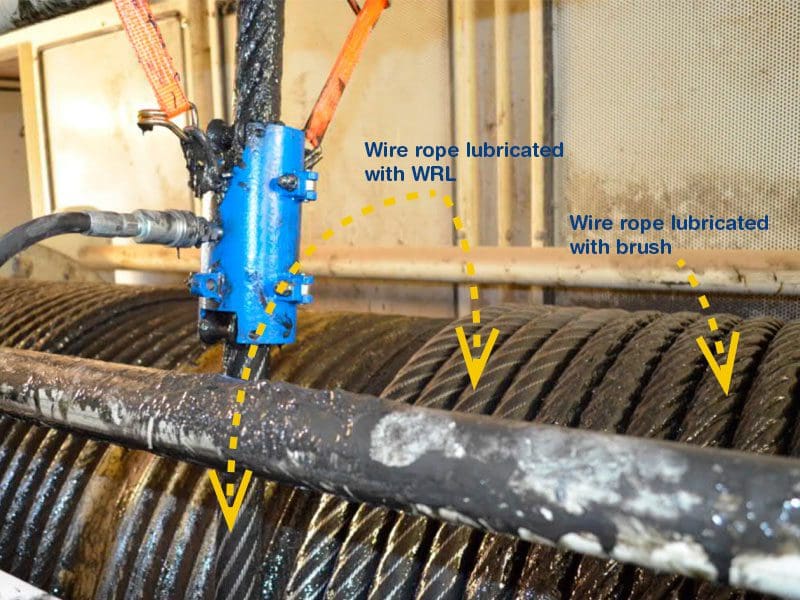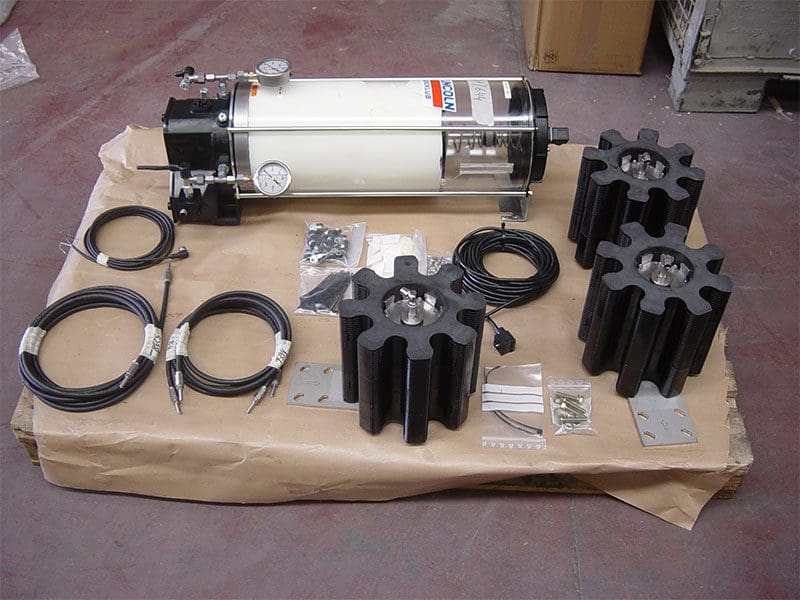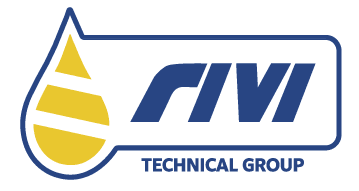Lubrication
systems and equipment
Special applications
In addition to traditional technical systems, to automate the lubrication of gears, bearings, guides, bushings, axles, and all types of mechanical components subject to friction and wear, RIVI Technical Group also works on special applications, specific for certain applications or mechanisms.
Special applications
COBRA / GVP: CHAIN CONVEYOR GREASING
COBRA / GVP – automatic greasing for Chain Conveyors, in operation. It is mainly used in the Automotive Industry (paint booths) and Iron & Steel Industry. It basically consists of a fixed structure on which a lubricant (grease) dispenser acts and can move laterally a certain distance, accompanying the conveyor wheel while it moves, and thus dosing grease inside the bolt through the nipple. At the end of the dosage, it returns to its initial position to repeat the sequence with another bolt. It is normally combined with a pneumatic cane pump, adaptable to a commercial drum.
WRL: WIRE ROPE LUBRICATION
This is a semi-automatic method for wire rope greasing, from 6 mm to 50 mm in diameter. It is mainly used in ships, harbor cranes, and other machinery subject to corrosion. It consists of a cylindrical casing, with wheels and retainers inside, so that the cable can pass freely. From a pumping equipment, normally adaptable to a commercial drum or can, grease is added to the casing inside while the wire circulates, generating a small pressure inside that improves the penetration of the lubricant among the wire rope filaments. Optionally, a cleaner can be installed at the entrance.
AIR-OIL
This system is extremely efficient, since low pressure compressed air is used to transport lubricant (oil) in a costant way and in very small quantities. Continuous lubrication is achieved, also preventing the entry of moisture or other impurities into the bearing chambers.
Additionally, it helps maintain working temperature. It is mainly used in the Iron & Steel industry. Air-oil circuits usually consist of a tank, a pump, dosing elements, mixing elements (air + oil), monitoring and control instruments, pipes and interconnection and support accessories.
Additionally, “lances” are used at the lubrication points (air-oil distributors that are inserted into the chocks).
This system can be applied using “Single Line” or “Progressive” technology.
MQL - OIL MICROSPRAY
This is a very widespread application in which the lubricant used is usually cutting fluid or other similar emulsions. The goal is to cool down the mechanisms used for metal treatment, mechanization and/or processing, generally referred to as “machine tools”.
The system adds fluid (water + oil, or similar) at frequent intervals or even uninterruptedly, synchronizing this dosage with compressed air so that it covers the required surface. In this case, besides lubricating, the goal is to cool. The oil is transported through a usually flexible pipe inserted into another pipe of larger diameter (externally concentric), through which the compressed air is transported. This pipe is called “coaxial”. The air and the oil mix at the outlet, producing the spraying.
PRIMER PINION
It is ideal for greasing low or medium speed open gears, with high loads and/or subject to corrosion. In the absence of compressed air (the ideal lubrication of an open gear is by spraying), the use of this greasing method is a perfect solution. It consists of a pinion that rotates freely around its axle, receives lubricant in a controlled manner, and transmits it by contact right on the tooth side that is going to engage. It is used in combination with any of the classic greasing systems to dose the precise amount of lubricant. There are several materials and versions available. Greases with a high NLGI grade (consistancy) are usually used.
RLS - RAIL AND TRACK GREASING
It involves the controlled dosing of lubricant onto the friction areas between wheel and track (railway or tramway) prior to a curve. Normally it is applied on the outer rail gauge face, and occasionally on the counterrail (if there is one). It exceptionally minimizes the wear on both elements, and it increases passenger comfort. There are three application technologies, the most effective being the so-called “direct application”. The level of security, reliability and monitoring in these systems is extraordinary.
An RLS system consists of a vandal-proof cabinet, which is installed next to the tracks, in the area prior to the curve to be lubricated. All elements are integrated and protected within the envelope. The interconnection of conduits and wires to the track is carried out through a protected tube buried in areas with pedestrian access.
Currently RIVI Technical Group's RAAS systems are the most technologically advanced in the world.
RAAS - ACOUSTIC ATTENUATION ON RAILWAY CURVES
It involves the controlled dosing of lubricant onto the friction areas between wheel and track (railway or tramway) prior to a curve. Normally it is applied on the outer rail gauge face, and occasionally on the counterrail (if there is one). It exceptionally minimizes the wear on both elements, and it increases passenger comfort. There are three application technologies, the most effective being the so-called “direct application”. The level of security, reliability and monitoring in these systems is extraordinary.
An RLS system consists of a vandal-proof cabinet, which is installed next to the tracks, in the area prior to the curve to be lubricated. All elements are integrated and protected within the envelope. The interconnection of conduits and wires to the track is carried out through a protected tube buried in areas with pedestrian access.
Currently RIVI Technical Group's RAAS systems are the most technologically advanced in the world.
WHEEL FLANGE LUBRICATION
It involves projecting (without compressed air) or spraying (with compressed air) lubricant to railway or tramway vehicles' wheels on the track friction area (not on the rolling area). It is equivalent to RLS systems but in this case it is embedded, that is, the system is installed on board the vehicle. The technology is equivalent to the RAAS (acoustic attenuation) systems. Generally, onboard RLS systems are very common in Underground and Overground Trains, whereas onboard RAAS systems are mostly installed on Trams and Light Rails.
RAILWAY ELECTRIFICATION CATENARY GREASING
This system, designed and patented by RIVI Technical Group in 2012, allows the conductive wire of the railway electrification catenary to be greased, increasing the lifespan of the wire itself and the pantographs. In addition, it solves the "ice sleeve" (OCL icing) problem, thanks to the water-repellent property of lubricating greases. It can be installed on maintenance cars and railway trucks. It works by detecting the position of the conductive wire (catenary) and conveniently dosing the lubricating fluid (grease) to a greasing strip board placed on the pantograph itself. The system also has remote monitoring, GPS, and remote control. There is a standard version (pneumatic), which can be used both on high-speed railway routes (3,000 DC) with conventional network (25,000 AC), and the electric version, exclusive for use in autonomous vehicles (with voltage-free catenary). Installation requires a two-vane pantograph, vehicle speed signal, compressed air (standard version), and sufficient space inside and on the roof.
HYFLOW - FAST FILLING
These involves high-performance electrical equipment for grease transfer. They allow manual greasing or tank filling for centralized greasing systems in a fast, clean, efficient and economical manner. They are mainly used in places where the machinery requires centralized and automatic greasing systems, where there is no compressed air network; for example, in mobile machinery, mining, and wind turbines (especially offshore).
